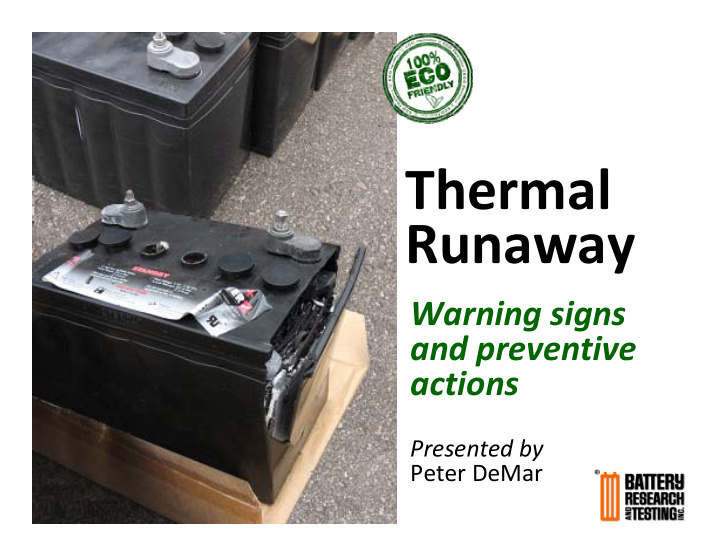



Thermal Runaway Warning signs and preventive actions Presented by Peter DeMar 1
If thermal Thermal runaway runaway does not scare you, then you are… 2
Thermal runaway Brand new to the stationary battery industry Ignorant of thermal runaway disasters 3
Thermal runaway Someone who realizes there are always warning signs Knows what they are Is applying the correct preventive measures 4
What is thermal runaway? CAUSED BY Excess of battery charging current Produces more internal heat than the battery can dissipate Thermal runaway can be detected , prevented and recovered from 5
Recovery = green benefit RECOVER a battery from thermal runaway and continue to use it Reduces carbon footprint for that battery GREEN benefit for the environment Good for your budget 6
The monster appears unexpectedly? “ It occurred without warning ” 7
The monster appears unexpectedly? There is ALWAYS an early warning We just did not understand the signals • They are obvious • There for many months! 8
What are these early warning signs? Increase in float current • Starts very slowly • Increases over time • Current through the battery • Not necessarily = charger meter 9
What are these early warning signs? Increase in float current Gradual increase in the temperature • Starts very slowly differential between • Increases over time cells and ambient • Current through the battery 10
What are these early warning signs? Increase in float current Gradual increase in the temperature • Starts very slowly differential between • Increases over time cells and ambient • Current through the battery These two items – when properly checked and tracked – will provide substantial warning so that you can take necessary actions to prevent a thermal runaway 11
What causes thermal runaway? Negative plate discharge and sulfation Increase in float current Dry out of cells Loss of electrolyte contact through AGM from plate to plate = inability of cells to dissipate internally generated excess heat 12
Preventing thermal runaway IEEE 1188 standard Maintain overall float voltage correct for ambient temperature Track temp. differential between cells and ambient monthly Track float current monthly Contact us for guidance on what “typical” float current should be for your battery 13
How to take the measurements Hand held meters Monitoring, such as the BEM device Keep accurate records and keep track of records Track readings for the life of the battery 14
Recovery after thermal runaway Re ‐ establish proper saturation Remove sulfates from the negative plates Install catalysts You can take a structurally intact battery from full ‐ blown thermal runaway and turn it back into a usable and reliable battery 15
Preventing thermal runaway Re ‐ establish proper saturation Remove sulfates from the negative plates Install catalysts You can prevent thermal runaway by applying these actions early 16
Who and what Now that the early warning signs of thermal runaway are so easily observed, just who is responsible when it occurs? 17
Who and what Now that the early warning signs of thermal runaway are so easily observed, just who is responsible when it occurs? YOU ARE. 18
Who and what Now that you understand that there is a means of recovering a battery from thermal runaway • You can be pro ‐ active instead of re ‐ active • You have time to determine just what actions are best for you 19
STATIONARY POWER SERVICES FOR INDUSTRY Experts in DC Systems a WBE Enterprise a WBE Enterprise GET IN + For further information please contact us. Contact us today for more information OUCH on how we can help you! Corporate Headquarters Gary L. Brewer President 1313 County Route 1 Oswego, NY 13126 Toll ‐ Free: (800) 221 ‐ 7123 Phone: (315) 342 ‐ 2373 Fax: (315) 342 ‐ 0797 (800) 221 ‐ 7123 (800) 221 ‐ 7123 www.batteryresearch.com www.batteryresearch.com 20
Recommend
More recommend